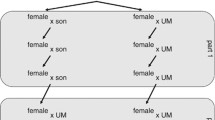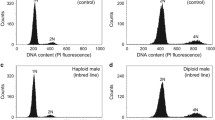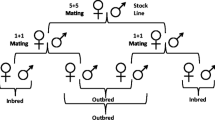Abstract
We previously determined that certain recessive genes decrease female fecundity in a haplo-diploid spider mite, Stigmaeopsis miscanthi (Saito). However, whether the depression was caused by the breakdown of heterosis or the expression of deleterious genes retained in a population could not be determined, because we had started our inbreeding experiment from a mixture of two isolated populations. In order to answer this basic question, inbreeding effects on survival and fecundity were measured for eight small populations occurring far from the two initial populations. There was little depression of immature survival of inbred lineages in all populations. On the other hand, in two inbred lineages, both originating from the smallest populations, female oviposition decreased significantly with the increase of Wrights f-value, showing that mildly deleterious genes are actually retained even in natural populations of haplo-diploid organisms.
Similar content being viewed by others
References
M.F. Antolin (1999) ArticleTitleA genetic perspective on mating systems and sex rations of parasitoid wasps Res. Popul. Ecol. 41 29–37
W. Atmer (1991) ArticleTitleOn the role of males Anim. Behav. 41 195–205
R.H. Crozier (1985) Adaptive consequences of male-haploidy W. Helle M.W. Sabelis (Eds) Spider Mites. Their Biology, Natural Enemies and Control. Vol. 1A Elsevier Amsterdam 201–222
H.J. Henter (2003) ArticleTitleInbreeding depression and haplodiploidy: experimental measures in a parasitoid and comparisons across diploid and haplodiploid insect taxa Evolution 57 1793–1803 Occurrence Handle14503621
H. Matsuda (1987) Conditions for the evolution of altruism Y. Ito J.L. Brown J. Kikkawa (Eds) Animal Societies. Theories and Facts Japan Sci. Soci. Press Tokyo 67–80
F. Mosteller C. Youtz (1961) ArticleTitleTables of the Freeman–Tukey transformations for the binomial and poisson distributions Biometrika 48 433–440
L.A. Pray C.J. Goodnight (1995) ArticleTitleGenetic variation in inbreeding depression in the red flour beetle Tribolium castaneum Evolution 49 176–188
W.R. Rice (1989) ArticleTitleAnalyzing tables of statistical tests Evolution 43 223–225
Y. Saito (1994) ArticleTitleIs sterility by deleterious recessives an origin of inequalities in the evolution of eusociality? J. Theor. Biol. 166 113–115 Occurrence Handle10.1006/jtbi.1994.1009 Occurrence Handle8145560
Y. Saito (1995) ArticleTitleClinal variation in male-to-male antagonism and weaponry in a subsocial mite Evolution 49 413–417
Y. Saito (1997) Sociality and kin selection in Acari J.C. Choe B.J. Crespi (Eds) The Evolution of Social Behaviour in Insects and Arachnids Cambridge University Press London 443–457
Y. Saito K. Mori A.R. Chittenden Y. Sato (2000a) ArticleTitleCorrespondence of male-to-male aggression to spatial distribution of individuals in field populations of a subsocial spider mite J. Ethol. 18 79–83 Occurrence Handle10.1007/s101640070004
Y. Saito K. Mori T. Sakagami J.Z. Lin (2004) ArticleTitleReinstatement of the genus Stigmaeopsis Banks, with descriptions of two new species (Acari: Tetranychidae) Ann. Entomol. Soc. Am. 97 635–646
Y. Saito K. Sahara (1999) ArticleTitleTwo clinal trends in male-male aggressiveness in a subsocial spider mite Behav. Ecol. Sociobiol. 46 25–29 Occurrence Handle10.1007/s002650050588
Y. Saito K. Sahara K. Mori (2000b) ArticleTitleInbreeding depression by recessive deleterious genes affecting female fecundity of a haplo-diploid mite J. Evol. Biol. 13 668–678 Occurrence Handle10.1046/j.1420-9101.2000.00198.x
S. Wright (1922) ArticleTitleCoefficient of inbreeding and relationship Am. Nat. 56 330–338 Occurrence Handle10.1086/279872
Author information
Authors and Affiliations
Corresponding author
Rights and permissions
About this article
Cite this article
Mori, K., Saito, Y., Sakagami, T. et al. Inbreeding depression of female fecundity by genetic factors retained in natural populations of a male-haploid social mite (Acari: Tetranychidae). Exp Appl Acarol 36, 15–23 (2005). https://doi.org/10.1007/s10493-004-8151-y
Received:
Accepted:
Issue Date:
DOI: https://doi.org/10.1007/s10493-004-8151-y




